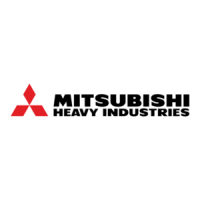
Do you have a question about the Mitsubishi Heavy Industries RC-HY20 and is the answer not in the manual?
| Heating Capacity | 2.0 kW |
|---|---|
| Cooling Capacity | 2.0 kW |
| Power Supply | 220-240V, 50Hz |
| Energy Efficiency Ratio (EER) | 3.21 |
| Coefficient of Performance (COP) | 3.61 |
| Refrigerant | R32 |
| Type | Heat Pump |
Details compatibility between remote controllers and indoor/outdoor units.
Covers general safety, symbols, and appliance usage guidelines.
Details safety steps for installation and operation, including refrigerant warnings.
Addresses safe practices for handling, cleaning, relocation, and repair of the unit.
Introduces the Hydrolution system and its quality features.
Explains the importance of filling in installation data for warranty.
Guides users on locating the product's serial number for service.
Highlights the advantages and properties of the RC-HY20/40-W control module.
Explains the basic operation and button functions of the control module.
Guides on how to adjust the indoor temperature via the control module.
Details the process for temporarily increasing hot water supply.
Describes the role and capabilities of the RC-HY20/40-W control module.
Explains the components of the control module's display unit and their functions.
Introduces the four main menus and basic information displayed on the control module.
Clarifies the meaning of various symbols shown on the control module's display.
Details how to navigate menus, select options, and set values on the control module.
Explains how to input text using the virtual keyboard on the control module.
Guides on navigating between different menu windows and steps.
Provides advice on routine maintenance and energy-saving practices for the heat pump.
Discusses factors affecting energy use and provides typical consumption examples.
Guides on adjusting indoor temperature using room sensors and manual settings.
Explains how to schedule heating based on weekdays and time periods.
Details how to schedule cooling periods for different days and times.
Provides access to advanced settings for heating and cooling curves.
Explains setting maximum and minimum supply temperatures for heating/cooling.
Sets minimum supply temperatures for heating and cooling operations.
Configures how room sensors affect heating/cooling based on a factor system.
Adjusts temperature differences and configures heat/cool sensors.
Allows users to define their own heating or cooling curves based on outdoor temperatures.
Modifies the heating curve at a particular outdoor temperature point.
Guides on temporary hot water increases and comfort mode settings.
Allows scheduling of hot water comfort for specific times and days.
Sets up periodic increases in hot water temperature to prevent bacterial growth.
Configures operating and downtime for the hot water circulation pump.
Shows current operating status, temperatures, and compressor statistics.
Displays information on additional heat settings, operation, and statistics.
Allows viewing average indoor temperatures week by week from the past year.
Guides on activating pool heating and setting temperatures and compressor limits.
Manages myUpway™ connection and configures TCP/IP network settings.
Guides on setting up proxy server details for internet connection.
Configures settings for the SG Ready function affecting temperature and hot water.
Configures electricity price role in heat pump operation and potential savings.
Selects energy sources based on price or carbon neutrality.
Sets the smart energy source mode and control method (Price/CO2).
Sets electricity prices for spot, tariff, or fixed price modes.
Defines the CO2 impact for different energy sources used by the system.
Configures tariff periods for electricity used for additional heating.
Allows selection of operating modes like auto, manual, or additional heat only.
Sets reduced temperatures for heating, hot water, and cooling during holidays.
Provides access to operating prioritization settings.
Configures degree minute settings for compressor and additional heat start/stop.
Allows scheduling to block specific functions like compressor or additional heat.
Sets specific time periods for the compressor to operate in silent mode.
Guides on how to interpret and respond to alarms displayed by the control module.
Provides solutions for low hot water, low room temperature, and basic operational problems.
Addresses problems with compressor start-up, high room temperature, and low system pressure.
Explains how to operate the system using only additional heating during faults.
Details filter cleaning for HSB and general maintenance for HMA units, including emergency mode.
Provides instructions for draining domestic hot water and heating systems.
Outlines periodic inspections and maintenance for PT300/500, including anode wear.
Provides steps for replacing the magnesium anode and cleaning the storage tank.
Covers external checks and cleaning of outdoor units, including grilles and drain holes.
States that detailed technical specifications are found in the installation manual.
Lists checks for safety valve and mixer valve related to hot water.
Covers system volume, safety valves, and internal heater checks for heating.
Lists checks for pipe system, condensation insulation, and reversing valve for cooling.
Includes checks for pipe length, height difference, pressure, and leak tracing.
Explains terms like Additional heat, Climate system, Compressor, Condenser, COP, etc.
Defines terms related to comfort, malfunctions, and operational aspects like DUT, Efficiency, etc.
Explains terms such as Pressostat, Radiator, Return pipe, Safety valve, Shuttle valve.
